Crusty and golden outside, this easy gluten-free Irish soda bread has a dense, tight crumb and is perfect for spreading with jam. No yeast or rising time is required to make this delicious gluten-free bread, which is completely dairy-free and vegan too! Bake a loaf or two and freeze to enjoy homemade bread on St. Patrick’s day or for anytime!
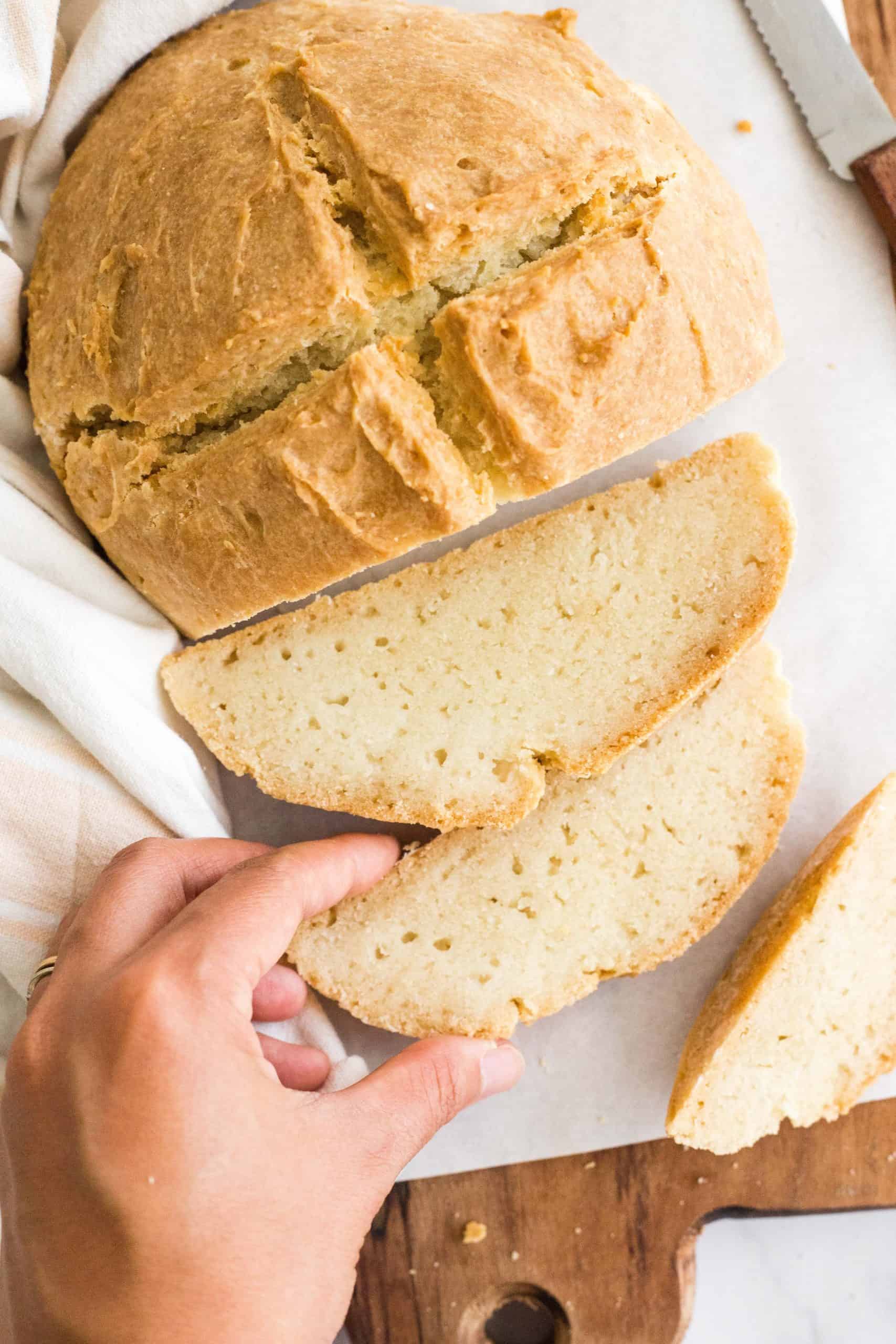
Want to save this recipe?
Enter your email & I’ll send it to your inbox. Plus, get great new recipes from me every week!
Jump to:
- Homemade Bread is the Best
- What is Irish Soda Bread?
- Why is there a Cross Cut in Irish Soda Bread?
- Gluten-Free and Dairy-Free Soda Bread
- Why This Recipe Works
- Ingredients You’ll Need:
- Ingredient Notes/Substitutions:
- How to Make Irish Soda Bread
- Dish by Dish Tips/Tricks:
- Recipe FAQs:
- Other Yeast-Free Breads You’ll Love:
- Gluten-Free Breads to Enjoy:
- Gluten-Free Irish Soda Bread (Dairy-Free, Vegan)
Homemade Bread is the Best
There’s just something about homemade bread that makes me feel all fuzzy inside. Nothing beats pulling out a freshly-baked loaf of bread from the oven and slicing into it, and then taking a big bite of bread that you’ve baked with your own hands.
While I certainly love baking yeast breads – from my soft, fluffy gluten-free bread, to soft gluten-free dinner rolls, to gluten-free pizza crust, and our recent favorite buckwheat bread, I’ll admit that sometimes I don’t always have the time or patience to wait for the dough to rise.
Sometimes, I just want to mix the dough together, and put it into the oven to bake. Which often means making a quick yeast-free bread that doesn’t require any rising time.
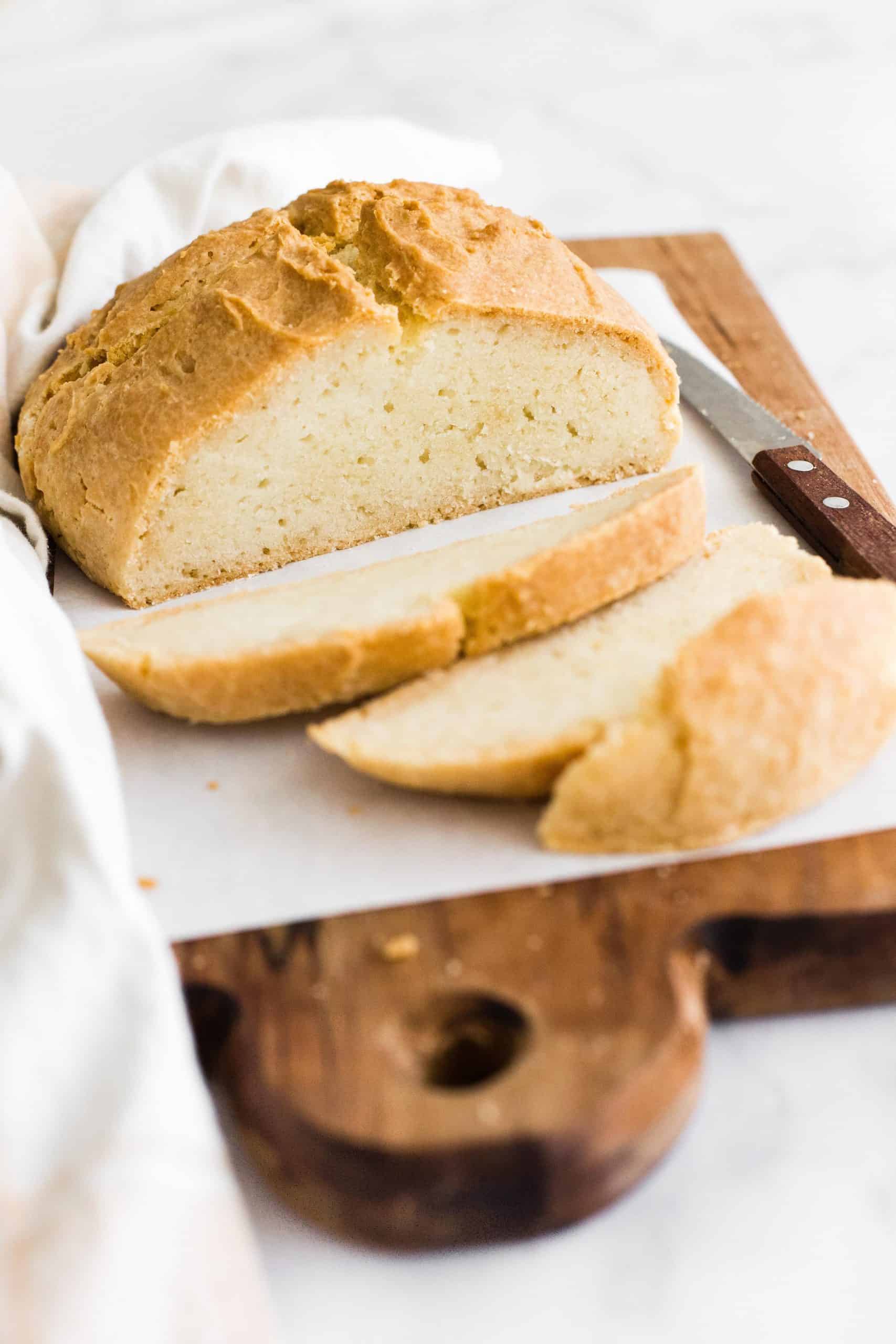
What is Irish Soda Bread?
If you aren’t familiar with the term “Irish soda bread”, it basically refers to a type of quick bread that uses baking soda (or “bread soda” as the Irish call it) for leavening instead of the traditional yeast.
Because it doesn’t require yeast, and hence no rising time is required, soda bread can be prepared quickly and easily. Not using yeast also results in the characteristic dense and hearty texture that we love about this bread.
Fun fact: Soda bread is most famously attributed to the Irish, but it was in fact first developed by the North Americans, but later replicated and adopted by the Irish.
Irish soda bread is often eaten during the St Patrick’s day feast and celebrations.
I just love how artisan it looks – feels like it’s fresh from a bakery!
Why is there a Cross Cut in Irish Soda Bread?
Soda bread may take on many forms, but one of the most common forms of this dense bread is a rounded shape with a cross cut on top of the dough, which is not only for the traditional look of soda bread, which was thought to ward off evil spirits.
Additionally, the scoring of the bread also has a wonderful baking benefit. Since the dough is shaped into a round ball, the center tends to be thicker and takes longer to bake compared to the sides of the ball (and will take much longer to cook).
By cutting a cross in the middle of the dough, it allows the heat to reach the middle of the dough, allowing the dough to expand and bake more evenly as it cooks.
Gluten-Free and Dairy-Free Soda Bread
Here’s a quick chemistry lesson for those interested: Since baking soda is alkaline in nature (sodium bicarbonate), it is necessary for an acid to be present in the ingredients so that upon reaction with the baking soda, tiny bubbles of carbon dioxide will be formed, and these bubbles are what will result in the leavening of this soda bread.
Typically, buttermilk is used as the liquid in making traditional soda bread because it contains lactic acid that will react with the baking soda. However, any acid will work too.
I wanted to create a gluten free Irish soda bread recipe that was both dairy-free and vegan, and in turns out that it’s actually easier than it sounds!
Instead of using normal buttermilk, I’ve used a combination of non-dairy almond milk and lemon juice. I’ve also added a bit of baking powder in addition to the baking soda to help give the bread a bit more rise.
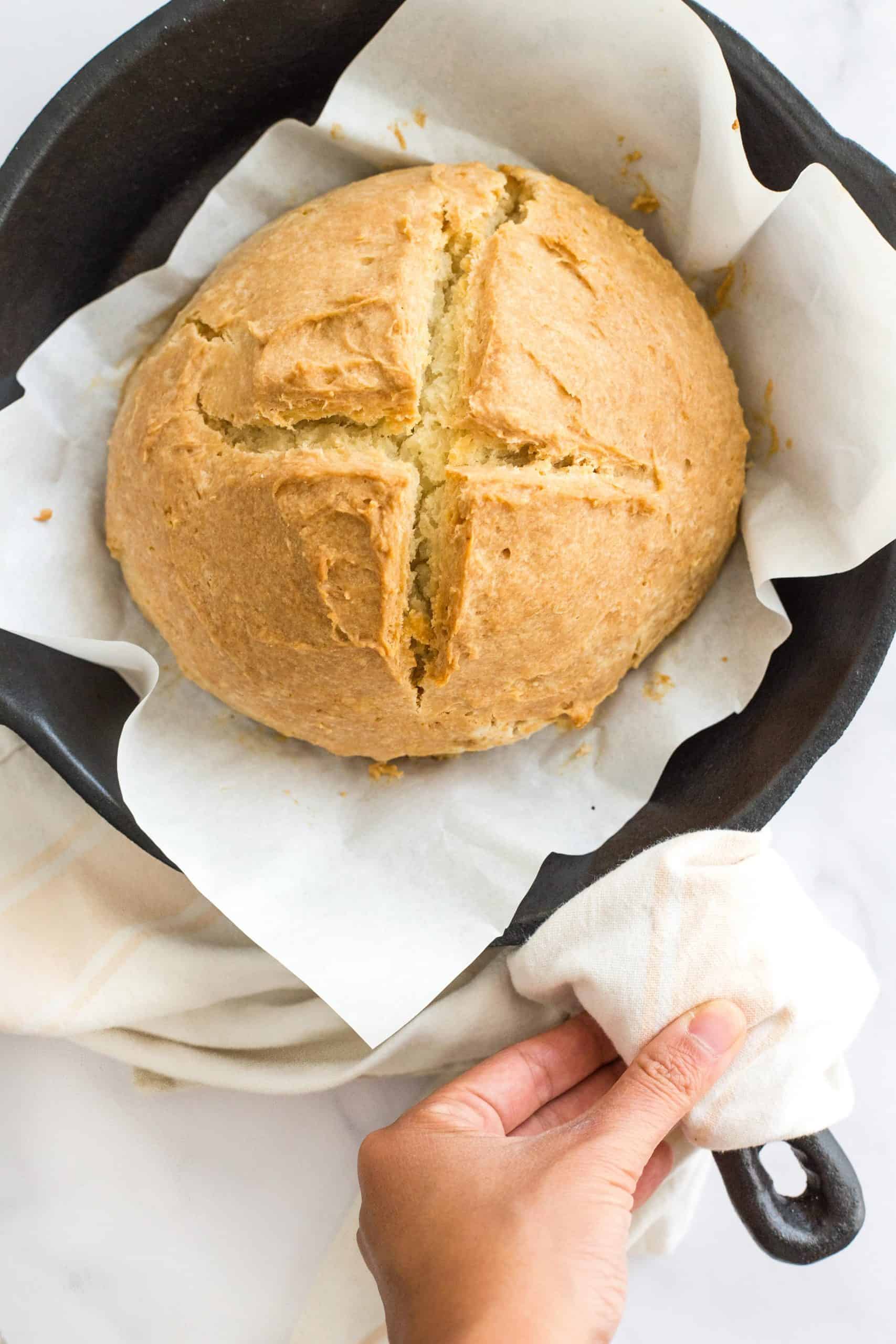
Why This Recipe Works
- Simple Ingredients: This recipe uses just a few recipes that easily accessible from the grocery store (nothing fancy required)!
- Easy to Make: All you need to do is to mix the dry ingredients with the wet ingredients to form the dough, which you can then shape and then bake (how much easier does it get?).
- Crusty Outside, Tender Inside: This recipe results in a beautiful, golden brown and impossibly crusty exterior, with a tender and dense crumb (similar in texture to quick breads). Some say that Irish soda bread has a scone like texture and flavor, and I have to agree. It can feel like you’re eating one extremely big scone.
- Flexible: I’ve sweetened the gluten-free soda bread slightly with just a bit of sugar in this case, but if you prefer to leave the sugar out for a non-sweet bread, that will totally work too!
- Totally Gluten-Free, Dairy-Free & Vegan The best part is that this Irish soda bread is 100% gluten-free, dairy-free, and vegan. This means that even those with Celiac disease or gluten or lactose intolerances, or those on a vegan diet can enjoy it without worries!
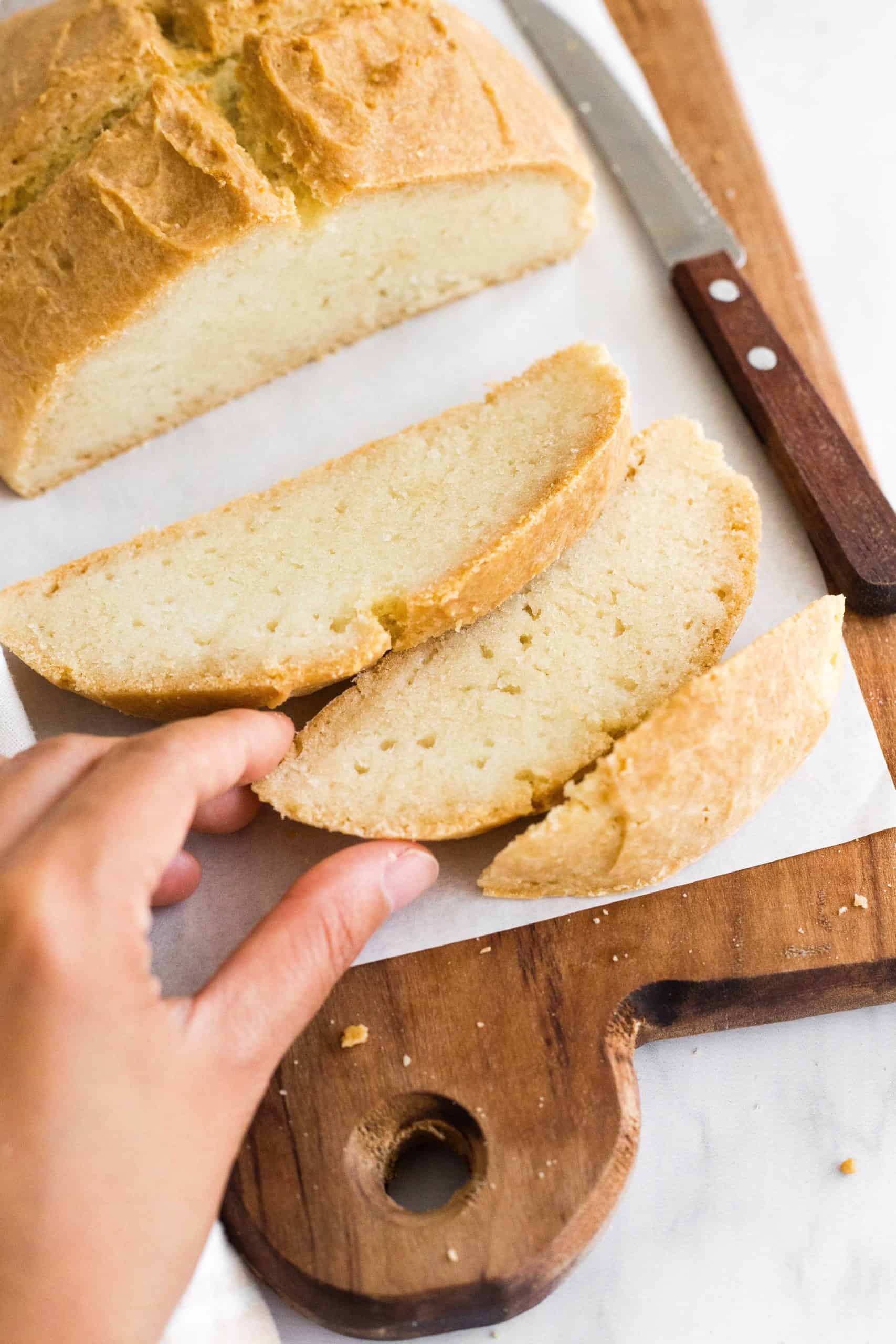
Ingredients You’ll Need:
Here’s a visual overview of the ingredients required for this gluten-free Irish soda bread recipe.
(For exact measurements, please scroll down to the printable recipe card at the bottom of this post.)
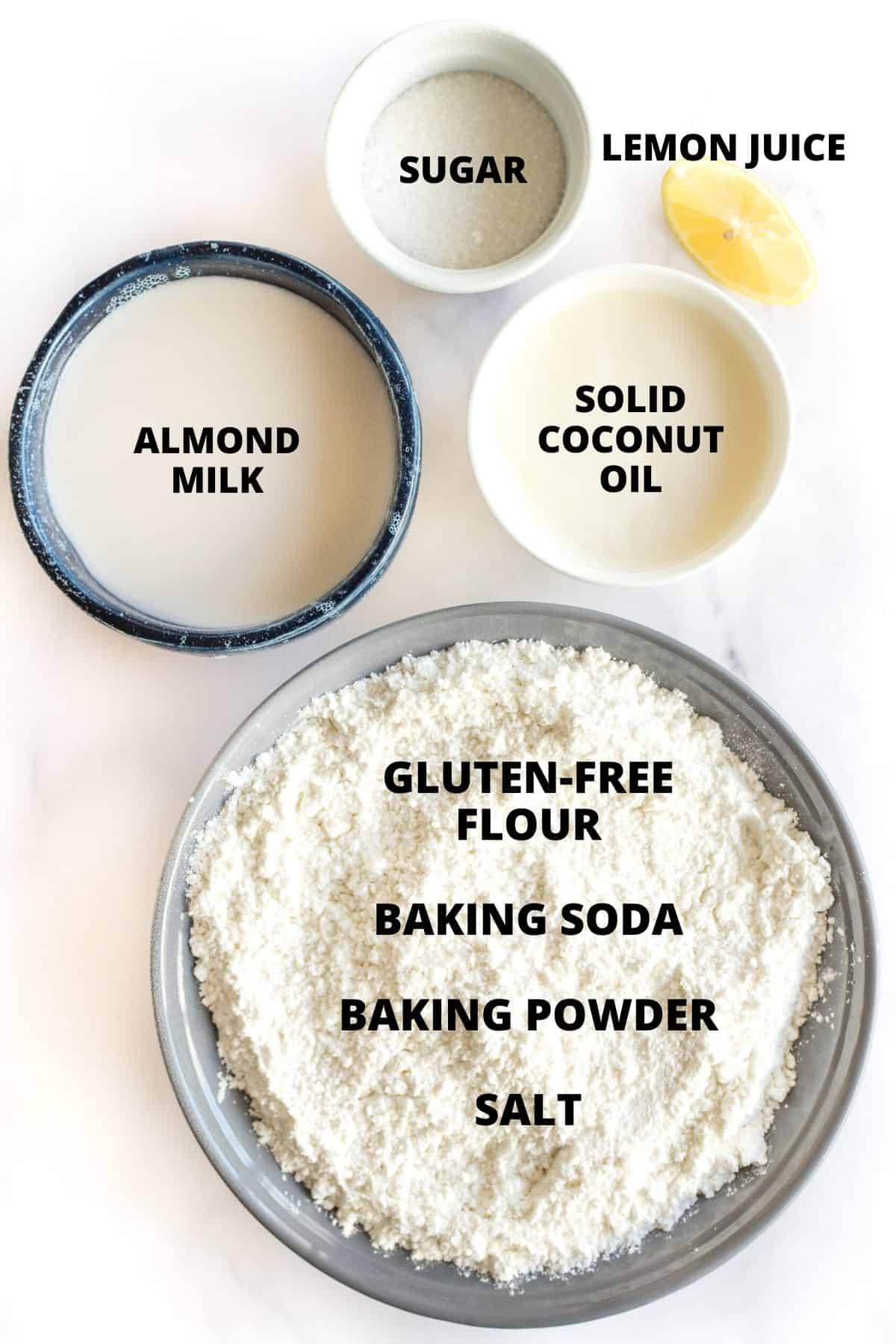
Ingredient Notes/Substitutions:
- Gluten-Free Flour Blend: I highly recommend using a good quality gluten-free all-purpose flour blend that is made up of lighter flours and starches such as rice flour, corn starch, potato starch and tapioca starch (this will ensure you get a lighter texture). I do NOT recommend using a flour blend that includes heavier flours such as garbanzo bean flour as that will result in a denser final texture.
- Xanthan Gum: Xanthan gum is the replacement for gluten in gluten-free flours. If your gluten-free flour blend does not include xanthan gum, make sure to include this in the mixture.
- Sugar: I like having a bit of sweetness in this bread, but if you prefer your bread not to be sweet, you can simply leave it out. I used granulated white sugar, but you may also use light brown sugar, dark brown sugar, or coconut sugar if you prefer (note that the darker sugars will make the dough and the insides of the soda bread slightly darker in color). If you are diabetic or insulin-resistant, I highly recommend using granulated monkfruit sweetener (a 1:1 sugar substitute that is zero glycemic-index and will not raise your blood sugar).
- Baking Soda: Since this is soda bread, we definitely need to include baking soda, so make sure you don’t leave it out.
- Baking Powder: I like adding a bit of baking powder to help the dough rise a little more. If you are Celiac or have gluten intolerances, make sure you use certified gluten-free baking powder.
- Coconut Oil: I like using refined coconut oil for baking as it has a neutral taste and flavor (as opposed to extra virgin coconut oil that has a more pronounced coconut smell and taste). Make sure your coconut oil is solid before incorporating it into the flour mixture. If your coconut oil is liquid, let it sit for 15 minutes in the freezer and it will turn solid. If you are not lactose-intolerant or vegan, feel free to use regular unsalted butter instead.
- Almond Milk: I like using my 5-minute homemade almond milk. You can also use other non-dairy milks such as cashew milk, tigernut milk, rice milk, coconut milk, soy milk, or sunflower seed milk. Alternatively, if you are not lactose-intolerant, you can use normal dairy milk.
- Lemon Juice: In this case, lemon juice is required as an acid to react with baking soda to form bubbles of air that will create the leavening effect. If you don’t have lemon juice, you can also use another acid such as apple cider vinegar or white vinegar in equal quantities.
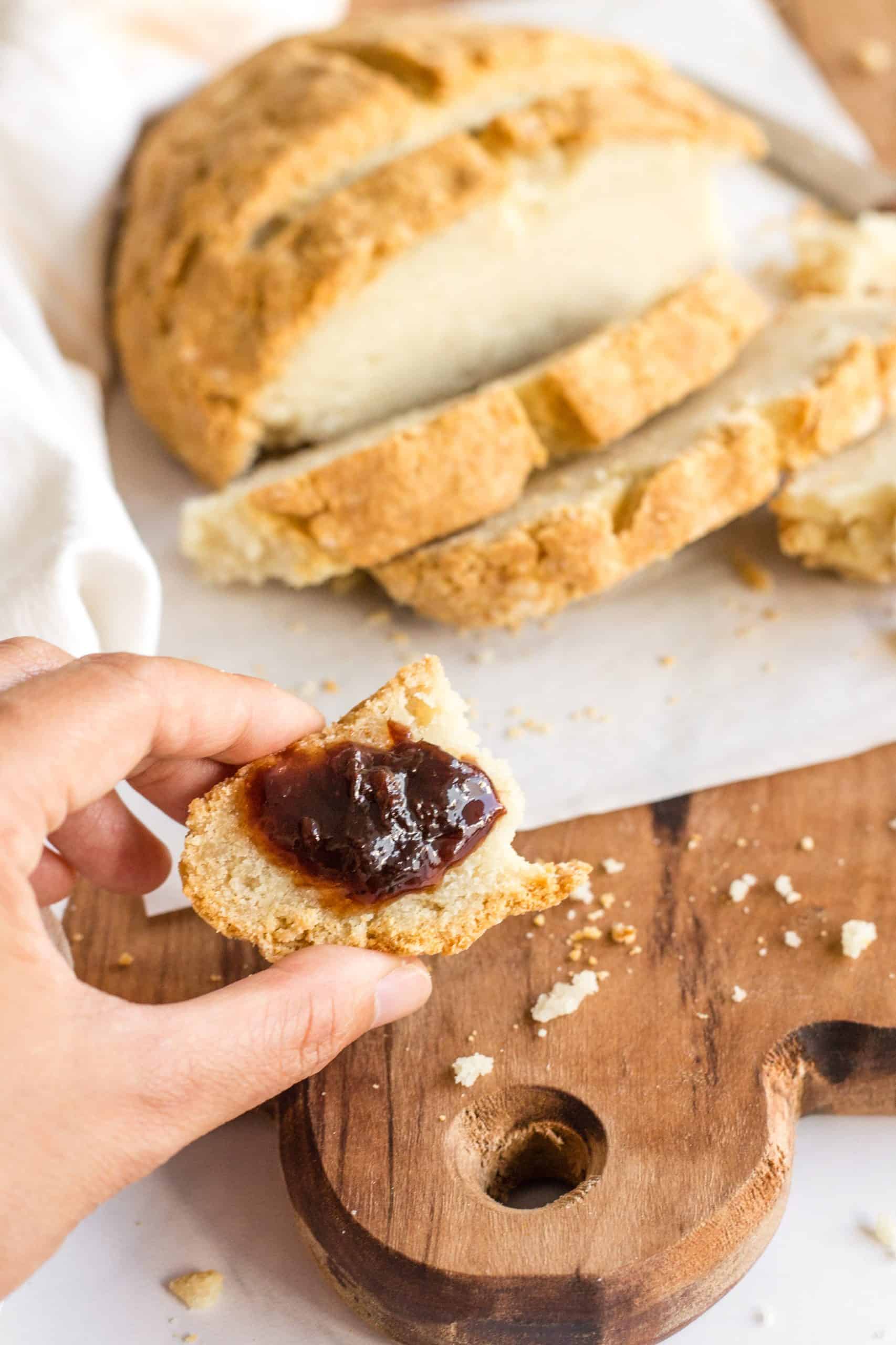
How to Make Irish Soda Bread
1. Preheat and Line
Preheat oven to 375F and line a cast iron skillet with parchment paper. Arrange oven rack to the middle position.
2. Combine Dry Ingredients
In a large mixing bowl, combine the gluten-free flour, xanthan gum (if using), sugar, baking soda, baking powder, and salt. Whisk well.
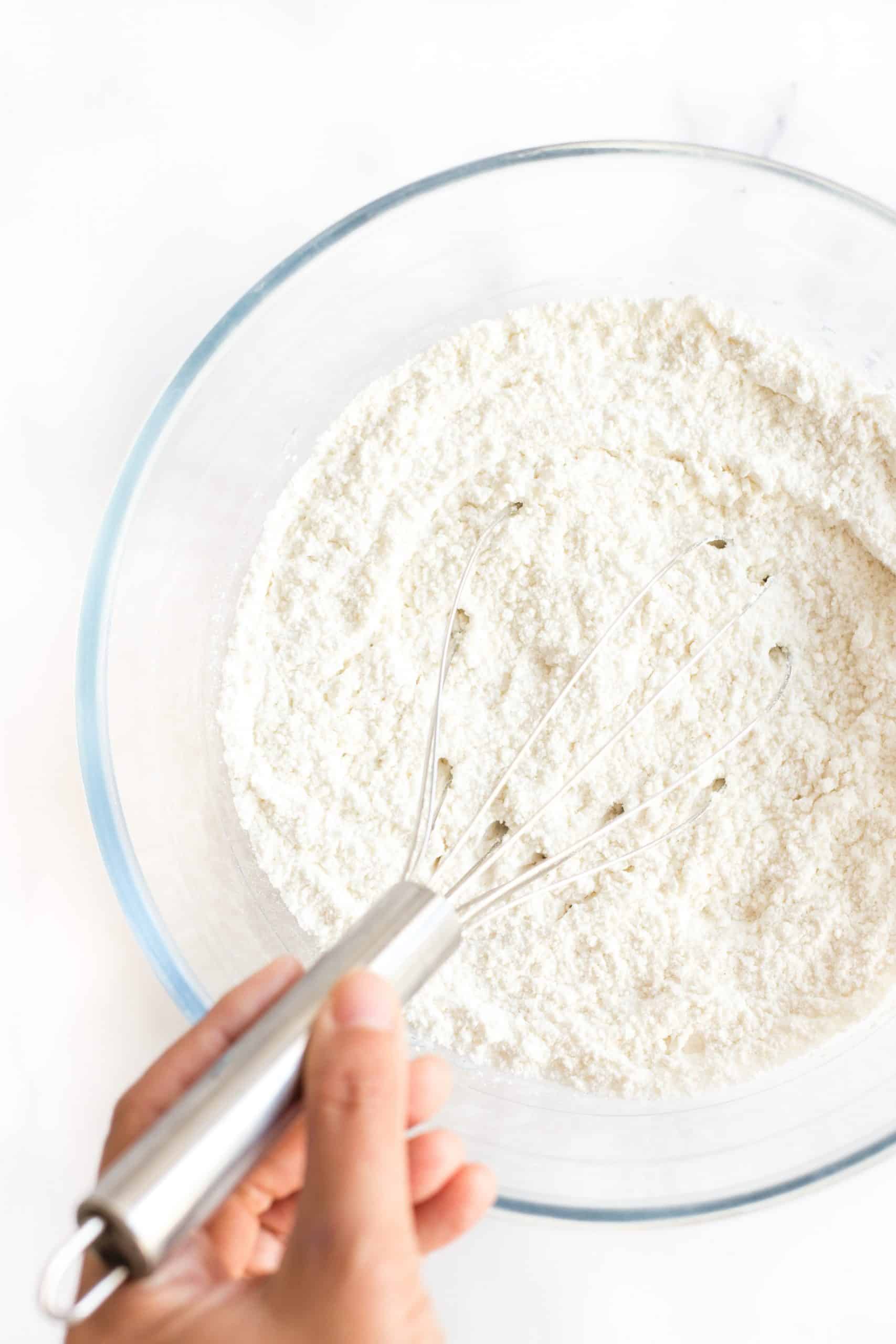
3. Incorporate Coconut Oil
Add the solid coconut oil to the flour mixture and press it into the flour with the back of a fork or a pastry cutter until all the coconut oil is incorporated (it will look like the texture of sand).
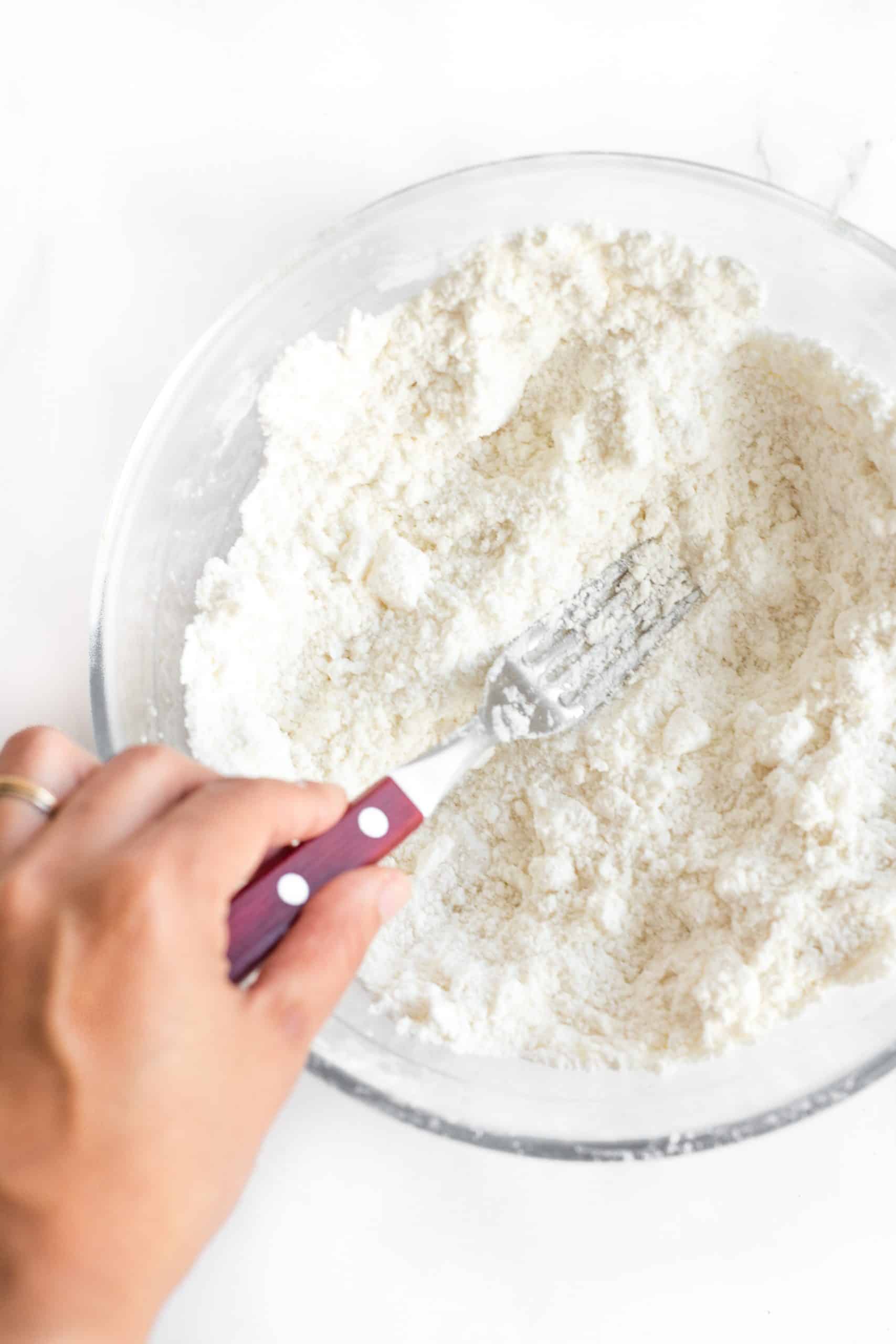
4. Form Dough
Add the almond milk and lemon juice, mixing until you get a sticky dough that you can shape into a round loaf (the dough will be wet and shaggy but it’s completely fine).
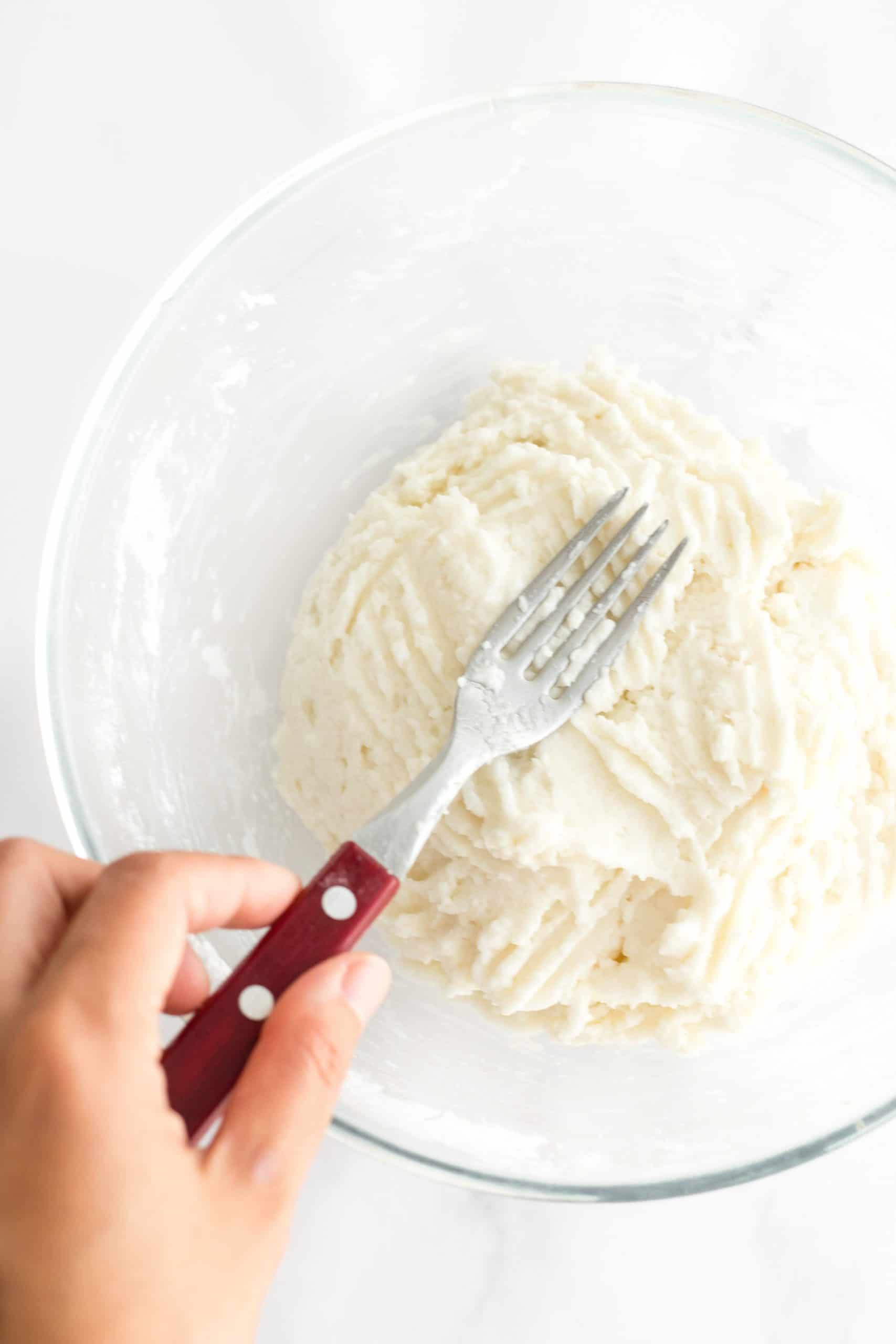
5. Place Dough in Lined Skillet
Transfer the ball of dough on parchment paper-lined cast iron skillet.
(Tip: A cast iron pan is recommended as cast iron retains heat well and will ensure that the bottom of the loaf turns out crusty, but if you don’t have a cast iron pan, a baking sheet, cookie sheet or a round cake pan will work fine too).
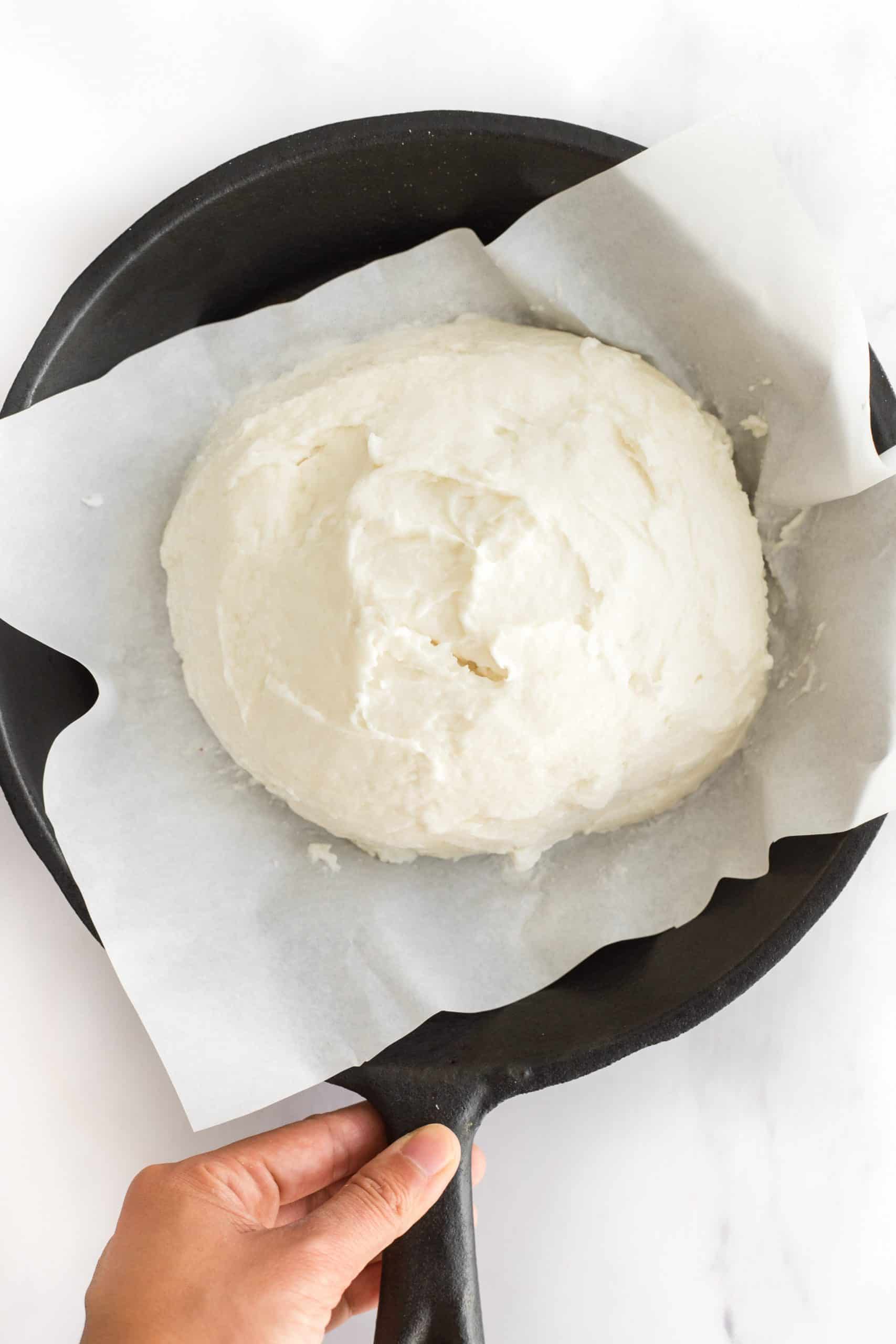
6. Cut a Cross on the Dough
Use a sharp knife to make a cross on the top of the loaf.
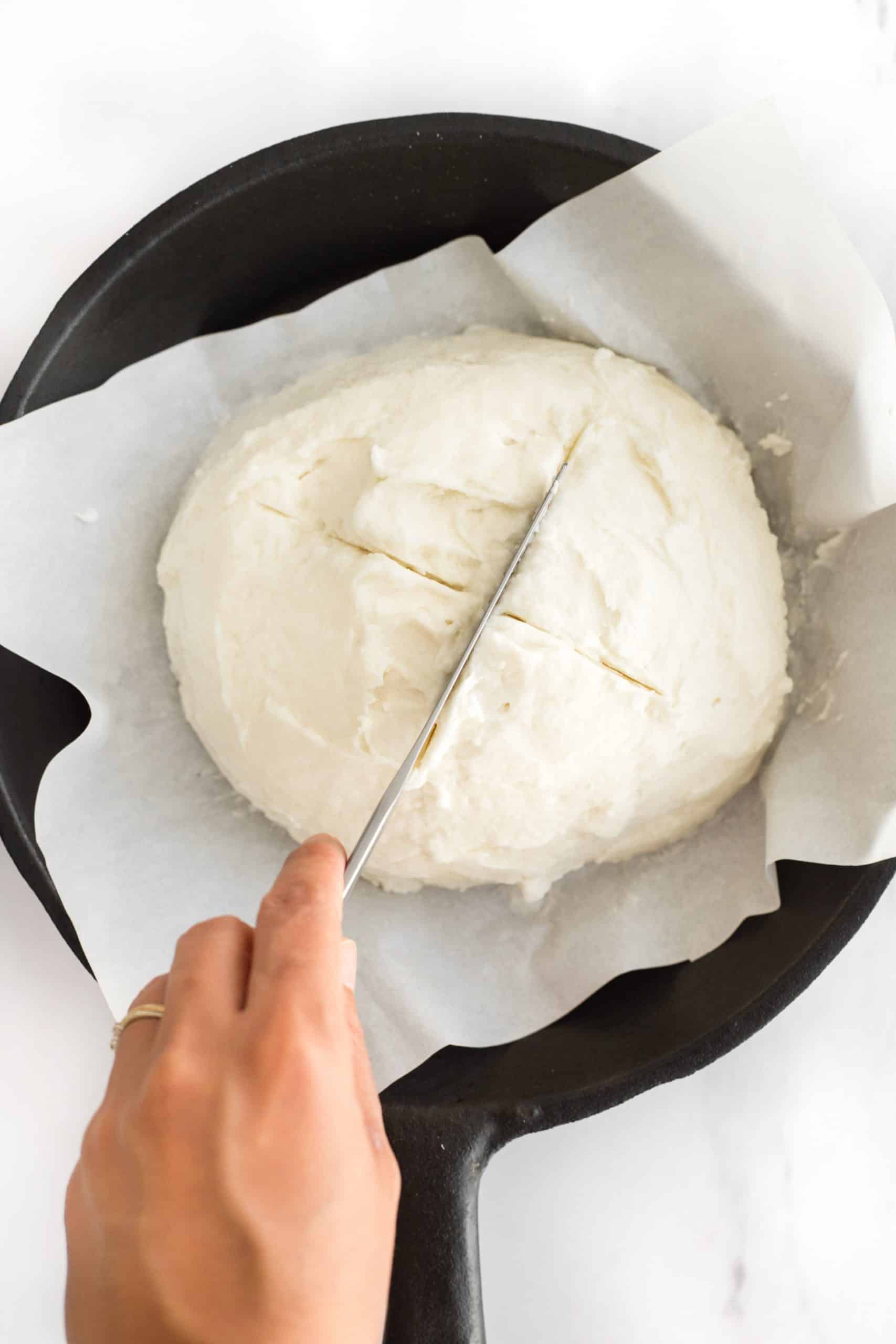
7. Bake Till Crusty
Let bread bake in the preheated oven for 55 minutes to 1 hour until golden brown and crusty on top and the loaf sounds hollow when you knock on it.
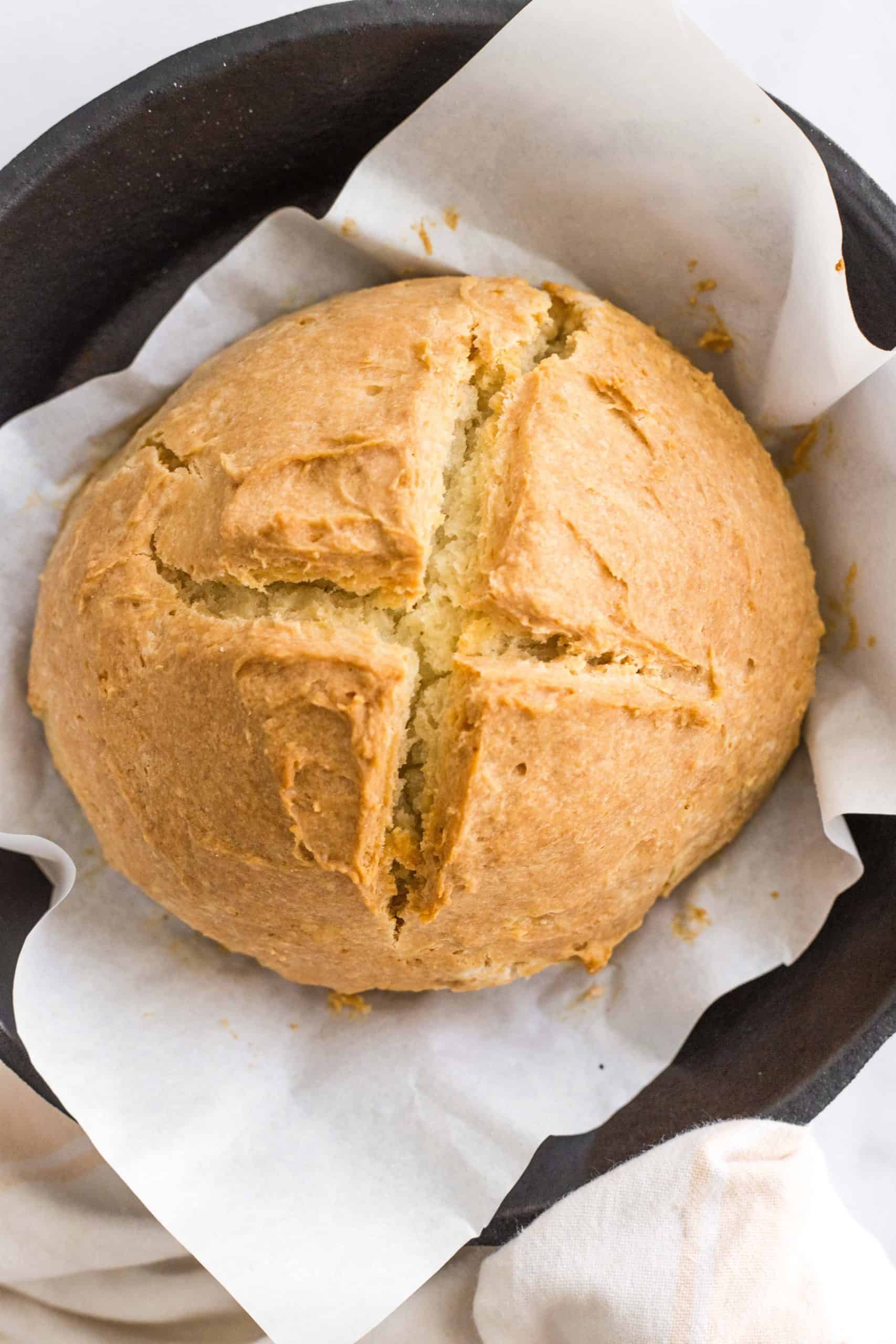
8. Cool Before Slicing
Allow the gluten-free soda bread to cool completely on a wire rack before slicing into it.
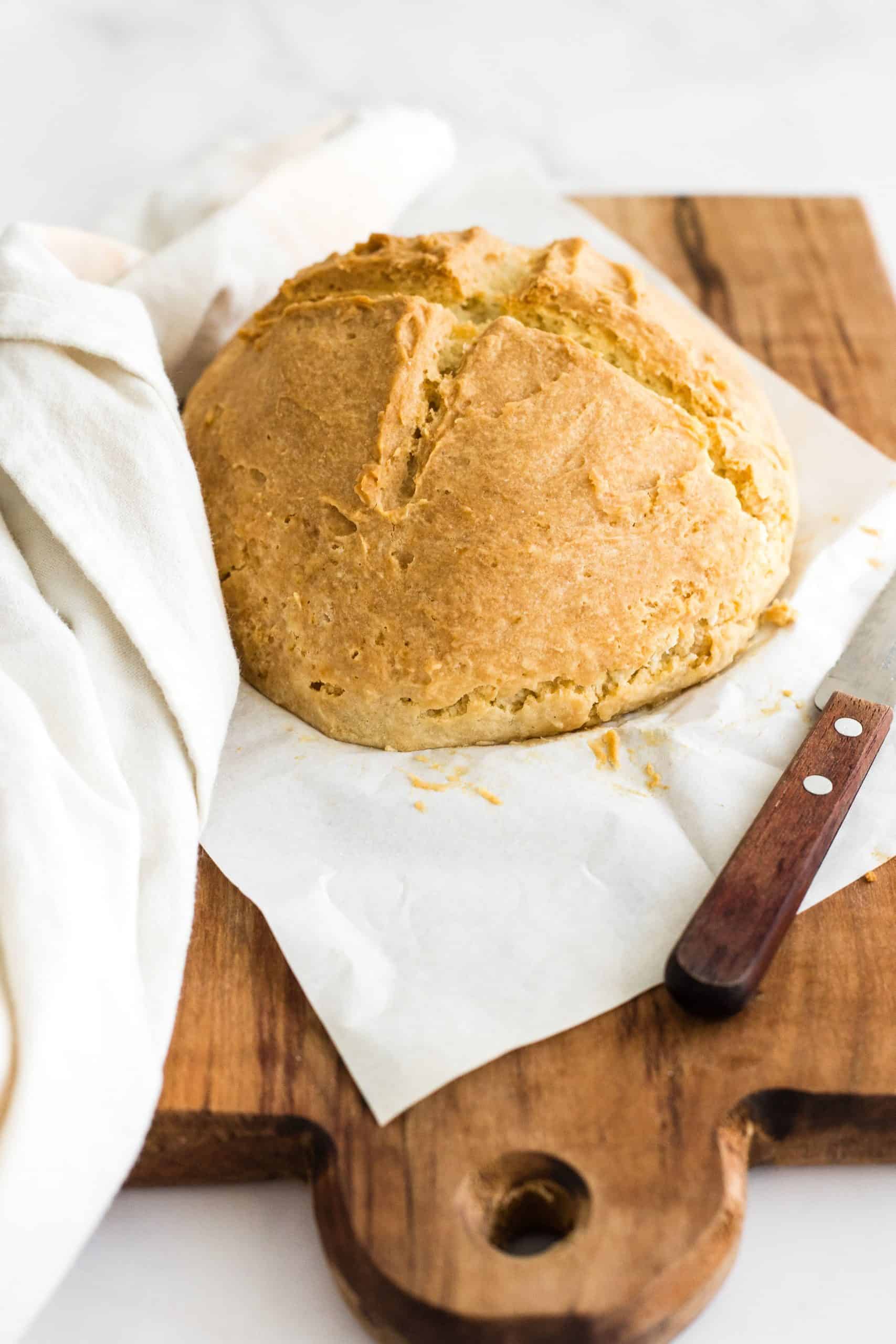
Dish by Dish Tips/Tricks:
- Cast Iron Skillet: I highly recommend baking the loaf in a cast iron skillet because it ensures that the bottom of the loaf turns out crust and brown too (since cast iron can retain heat very well).
- Cool Completely: Gluten-free bread requires cooling down so that it can finish cooking with the retained heat, and if you slice into it too early, it may have an unpleasant gummy texture. Make sure you allow the vegan soda bread to cool completely before slicing into it, even though it may be hard to resist slicing into the still-hot loaf. It’ll be worth it.
- Additional Add-Ins: Feel free to add a handful of golden raisins or golden sultans or even caraway seeds to the dough and mix well until thoroughly combined before baking.
- Make a Non-Sweet Version: If you don’t like sweet bread, simply leave out the sugar from the recipe.
- Make a Savory Version: If you like a savory gluten free soda bread recipe instead, leave out the sugar and add another 1/2 teaspoon of salt.
- Use a Serrated Knife: When cutting into the soda bread loaf, it’s best to use a serrated bread knife (a knife with ridged edges) so it cuts better, as opposed to using a knife with a smooth edge.
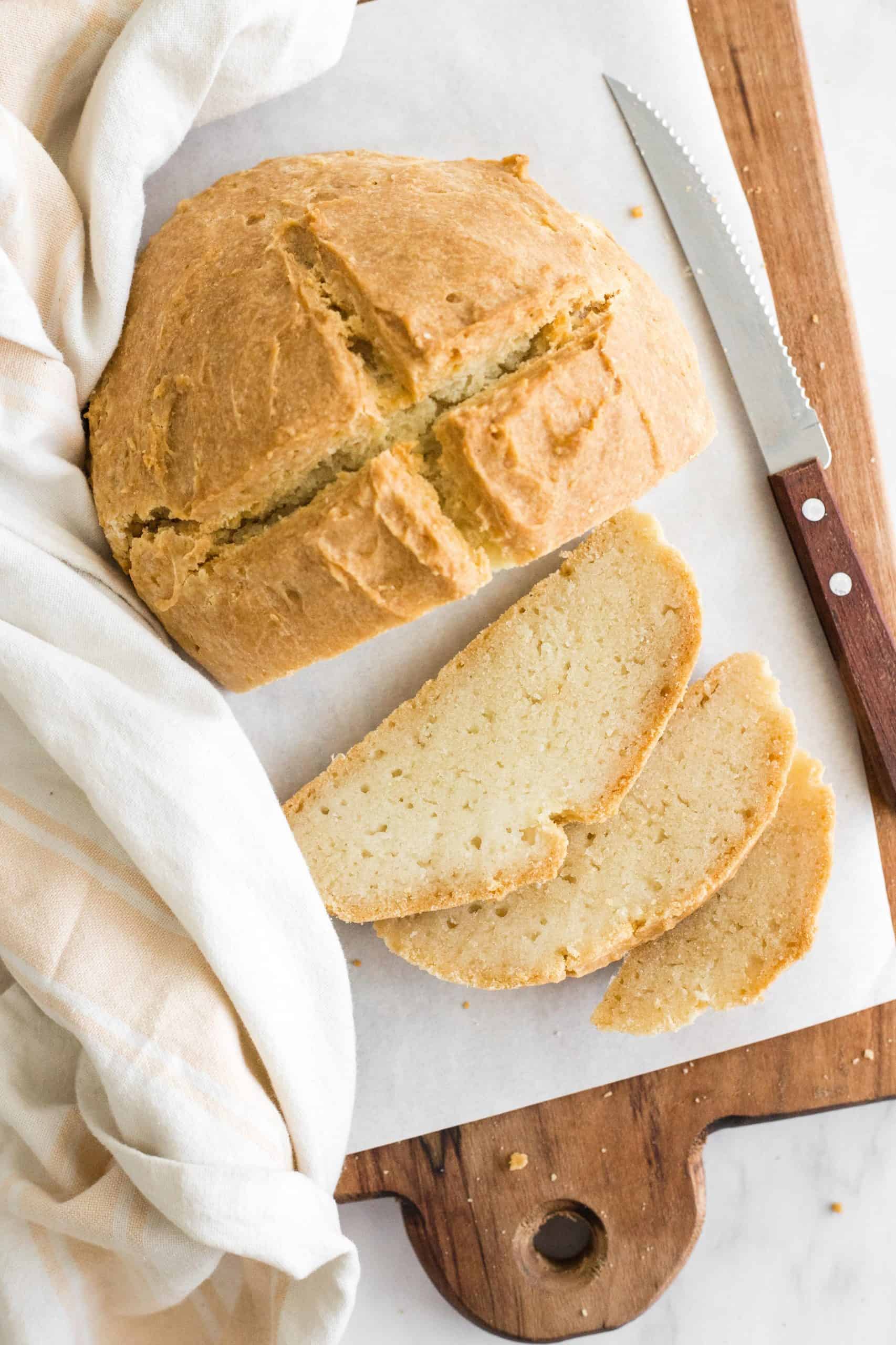
Recipe FAQs:
To store this no-knead Irish soda bread, cover it with plastic wrap at room temperature for up to 5 days.
To freeze, cover the cooled gluten-free Irish bread in plastic wrap or a freezer-safe airtight container or ziplock bag and freeze for up to 3 months. Allow the bread to thaw completely overnight before slicing into it and toasting.
A traditional Irish soda bread recipe usually contains wheat flour (which has gluten), so most store-bought Irish soda breads probably contain gluten and are not safe for Celiacs or those who are gluten-intolerant (unless the loaf is specified to be gluten-free).
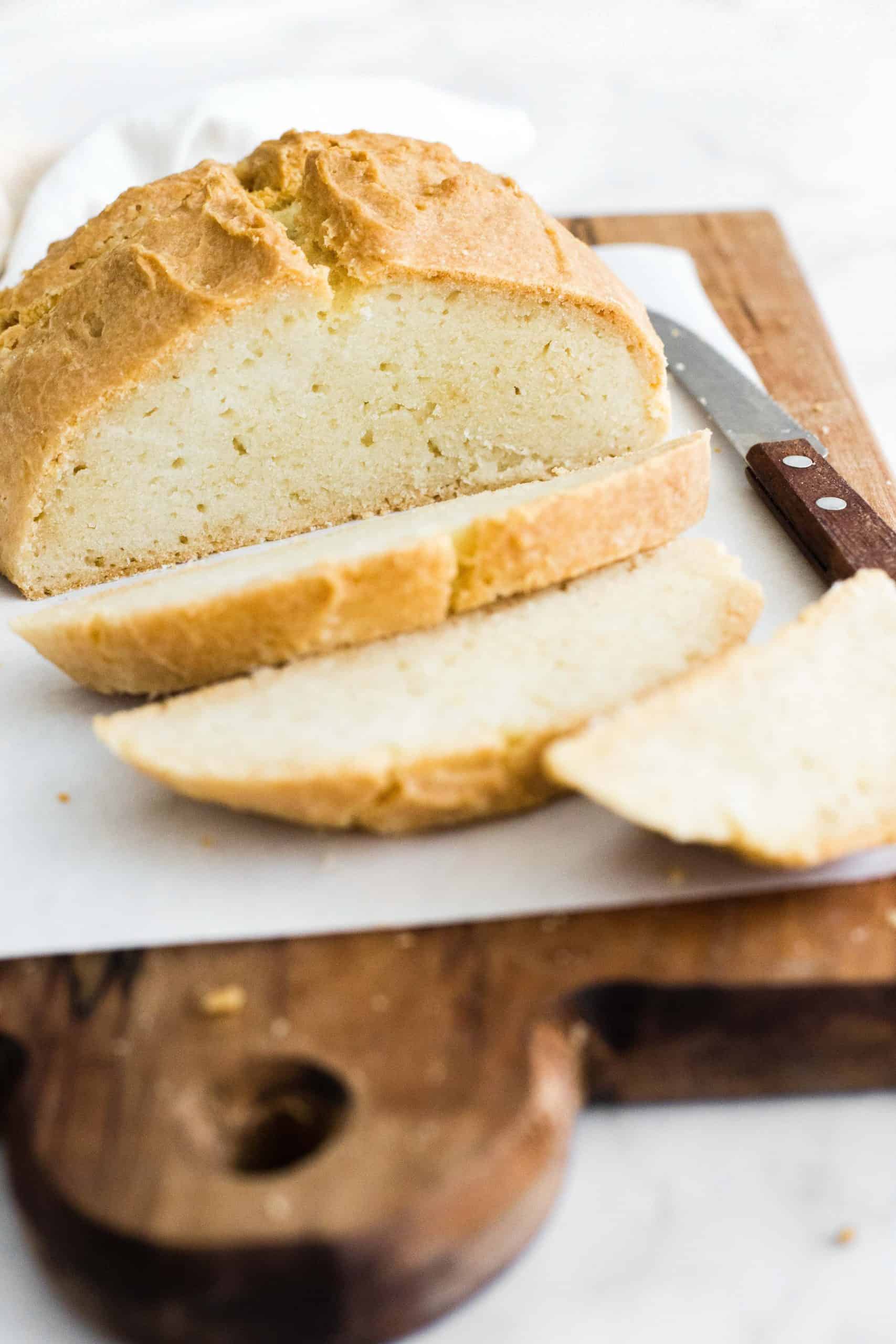
Other Yeast-Free Breads You’ll Love:
- Irish Brown Bread (Gluten-Free, Vegan)
- Gluten-Free Naan Bread (Dairy-Free, No-Yeast)
- Easy Honey Oat Bread (Gluten-Free, Dairy-Free Option)
- Honey Quinoa Bread (Gluten-Free, Dairy-Free)
- Low Carb Almond Flour Bread (Gluten-Free, Dairy-Free)
- Low Carb Coconut Flour Bread (Gluten-Free, Dairy-Free)
- Flaxseed Coconut Bread (Gluten-Free, Dairy-Free)
- Easy Flaxseed Bread (Gluten-Free, Dairy-Free)
Gluten-Free Breads to Enjoy:
P.S. If you try this recipe, I’d love for you to leave a star rating below, and/or a review in the comment section further down the page. I always appreciate your feedback. Be sure to check out my entire Recipe Index for all the recipes on the blog. You can also follow me on Pinterest, Facebook or Instagram! Sign up for my Email List to get fresh recipes in your inbox each week!
Print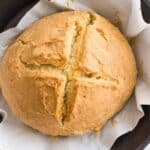
Gluten-Free Irish Soda Bread (Dairy-Free, Vegan)
- Total Time: 1 hour 5 minutes
- Yield: 1 loaf 1x
- Diet: Gluten Free
Description
Crusty and golden outside, soft and tender inside, this easy gluten-free Irish soda bread has a dense, tight crumb and is perfect for spreading with jam. No yeast or rising time is required to make this delicious gluten-free soda bread, which is completely dairy-free and vegan too! Bake a loaf or two and freeze to enjoy homemade bread anytime!
Ingredients
- 3 cups gluten-free all-purpose flour
- 1 teaspoon xanthan gum (leave out if your flour blend includes it)
- 1/4 cup sugar
- 1 teaspoon baking soda
- 1 teaspoon baking powder
- 1/2 teaspoon salt
- 1/2 cup coconut oil, chilled and solid
- 1 1/2 cups almond milk
- 2 tablespoons lemon juice
Instructions
- Preheat and Line: Preheat oven to 375F and line a cast iron skillet with parchment paper. Arrange oven rack to the middle position.
- Combine Dry Ingredients: In a large bowl, combine the gluten-free flour, xanthan gum (if using), sugar, baking soda, baking powder, and salt. Whisk well.
- Incorporate Coconut Oil: Add the solid coconut oil to the flour mixture and press it into the flour with the back of a fork until all the coconut oil is incorporated (it will look like the texture of sand).
- Form Dough: Add the almond milk and lemon juice, mixing until you get a shaggy dough that you can shape into a ball (the dough will be wet and shaggy but it’s completely fine).
- Transfer Dough to Pan: Place the ball of dough on parchment paper-lined cast iron skillet.
- Cut a Cross on Dough: Use a knife to make a cross on the top of the bread.
- Bake Till Crusty: Bake bread for 55 minutes to 1 hour until golden brown and crusty on top and the loaf sounds hollow when you knock on it.
- Cool Completely: Allow the Irish soda bread to cool completely before slicing into it.
Notes
Gluten-Free Flour Blend: I highly recommend using a good quality gluten-free all-purpose flour blend that is made up of lighter flours and starches such as rice flour, corn starch, potato starch and tapioca starch (this will ensure you get a lighter texture). I do NOT recommend using a flour blend that includes heavier flours such as garbanzo bean flour as that will result in a denser final texture.
Xanthan Gum: Xanthan gum is the replacement for gluten in gluten-free flours. If your gluten-free flour blend does not include xanthan gum, make sure to include this in the mixture.
Sugar: I like having a bit of sweetness in this bread, but if you prefer your bread not to be sweet, you can simply leave it out. I used granulated white sugar, but you may also use light brown sugar, dark brown sugar, or coconut sugar if you prefer (note that the darker sugars will make the dough and the insides of the soda bread slightly darker in color). If you are diabetic or insulin-resistant, I highly recommend using granulated monkfruit sweetener (a 1:1 sugar substitute that is zero glycemic-index and will not raise your blood sugar).
Baking Soda: Since this is soda bread, we definitely need to include baking soda, so make sure you don’t leave it out.
Baking Powder: I like adding a bit of baking powder to help the dough rise a little more. If you are Celiac or have gluten intolerances, make sure you use certified gluten-free baking powder.
Coconut Oil: I like using refined coconut oil for baking as it has a neutral taste and flavor (as opposed to extra virgin coconut oil that has a more pronounced coconut smell and taste). Make sure your coconut oil is solid before incorporating it into the flour mixture. If your coconut oil is liquid, let it sit for 15 minutes in the freezer and it will turn solid. If you are not lactose-intolerant or vegan, feel free to use normal dairy butter instead.
Almond Milk: I like using my 5-minute homemade almond milk. You can also use other non-dairy milks such as cashew milk, tigernut milk, rice milk, coconut milk, soy milk, or sunflower seed milk. Alternatively, if you are not lactose-intolerant, you can use normal dairy milk.
Lemon Juice: In this case, lemon juice is required as an acid to react with baking soda to form bubbles of air that will create the leavening effect. If you don’t have lemon juice, you can also use another acid such as apple cider vinegar or white vinegar in equal quantities.
Cast Iron Skillet: I highly recommend baking the loaf in a cast iron skillet because it ensures that the bottom of the loaf turns out crust and brown too (since cast iron can retain heat very well).
Storing/Freezing: To store the bread, cover it with plastic wrap at room temperature for up to 5 days. To freeze, cover the cooled bread in plastic wrap or a freezer-safe airtight container or ziplock bag and freeze for up to 3 months. Allow the bread to thaw completely overnight before slicing into it and toasting.
This recipe was originally posted in March 2021, but has since been republished to include clearer step-by-step instructions, as well as recipe notes and substitutions.
Adapted from: My Gluten-Free Kitchen
- Prep Time: 5 mins
- Cook Time: 1 hour
- Category: Bread
- Method: Baking
- Cuisine: Irish

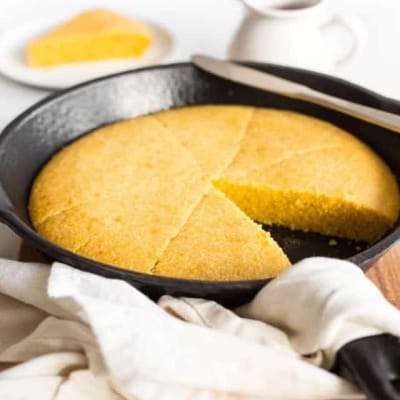
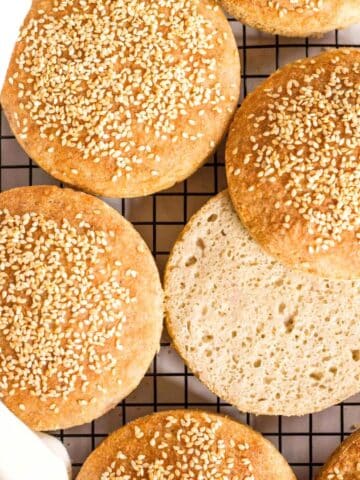
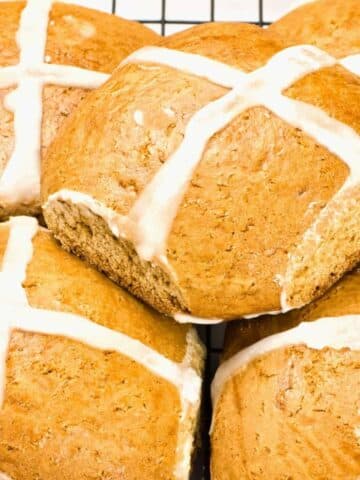
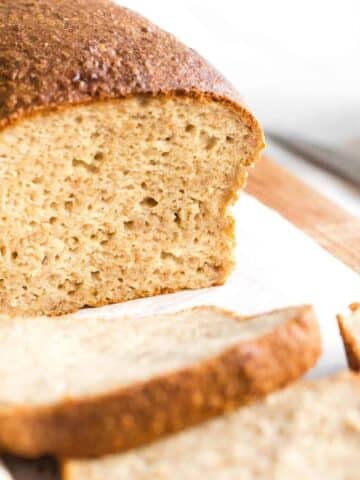
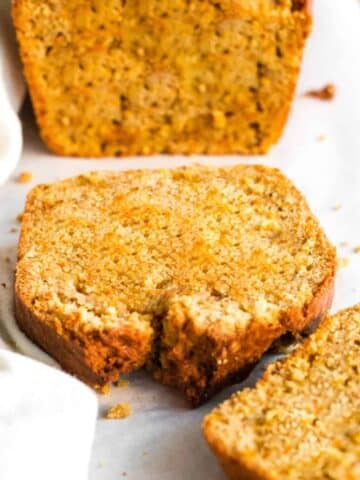
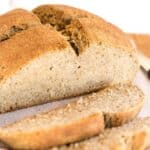
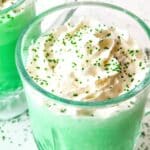




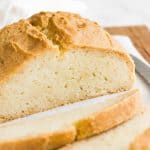
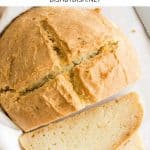
Mine came out dry, bland and tasteless. I’ll try again maybe with raisins.
Hi Susan, sorry to hear that, perhaps you would enjoy it better with raisins. Soak the raisins first in warm water until they are plump for best results.
Hello! I was so excited to try this bread! It’s cooling as I type this 🙂. Mine doesn’t look quite as pretty, it has lots of cracks. Also there’s quite a bit of oil at the bottom of the bread, like a lot of the coconut oil leaked out🤷🏻♀️. Is that normal or do I mess something up in the process? Thanks!
Hi Whitney! Let’s troubleshoot – if your bread has a lot of cracks, it could be that the dough was not wet enough. Usually once I finish shaping the loaf and it’s in the skillet, I use wet fingers to smooth out the top of the surface (this was create a smoother top). As for the coconut oil leaking out, that’s not common. It could be that the coconut oil was not properly incorporated into the dough, and that there might have been big chunks of coconut oil that were at the bottom of the dough, and hence when the bread was in the oven, the chunks of incorporated coconut oil melted and leaked out (that’s my guess at least). Maybe you can let the coconut oil soften a little before incorporating it into the dough to make it easier for it to be fully incorporated (which will give you a wetter and stickier dough), but then chill the dough a little before shaping so it’s easier to work with. Hope this helps!
Can you put the bread on parchment on a pizza stone if you don’t have cast iron or will that hurt the shape
Hi Joan! That should work as well! 🙂 Hope you enjoy the bread!
Terrific and very tasty, thoroughly enjoyed the resulting loaf.
I didn’t worry about the Baking Powder. just increased the Baking Soda and added Apple Cider Vinegar, Baking Powder is Baking Soda with something like Cream of Tartar as the powdered acidifyer.
Hi Hugh! Glad to hear you enjoyed this Irish soda loaf 🙂 Hope to see you around the blog again sometime soon!
This recipe was perfect. I substituted coconut oil with vegetable butter and used oat milk instead of almond milk. The bread was moist and delicious. Would definitely make again.
Hi Joy! Thank you for letting me know how it went (and with the different substitutions too). Hope to see you around the blog again sometime soon!
Hi Felicia,
I made this bread last week to go with a “vegan” chicken liver pate for my YouTube channel (I will, of course, link back to your recipe in the description), and I loved it! I used a barista plant milk (blend of pea, coconut and oat) and it worked so well. A couple of questions if I may;
-The crust was VERY thick; maybe an inch, do you have any tips for getting it thinner? I baked at 350°F/180°C in a fan oven. I wondered if maybe I should do cooler for longer, and maybe cover once it’s coloured…
-Could you explain why the oil has to be hard? I’ve got joint issues and crushing it into the flour really hurt my hands. I’m thinking of ways to reduce the load on my fingers; perhaps blending in the food processor with the dough blades? Alternatively, maybe melting the oil, mixing it in, then cooling down and breaking up once cool again.
Any help would be much appreciated!
Rachel
Hi Rachel, thank so much for your note and for the linkback from your Youtube channel. Glad you enjoyed this bread with the vegan chicken liver pate (sounds delish!).
Now let’s troubleshoot:
Regarding the crust, you could cover the bread with aluminium foil once the crust is browned to prevent it from being too thick and hard. As for the coconut oil, the reason why we use solid coconut oil is so that the dough is easier to work with and shape (if not it will be too liquid). The alternative (in your case since your joint issues make it hard to crush the solid coconut oil in the the flour) is to use liquid coconut oil and mix all the ingredients together to get a more liquid dough, then let the dough chill for 5 to 10 minutes for it to be a a little easier to shape.
Hope this helps, and would love to see you around the blog again sometime soon!
xx,
Felicia
Instead of almond milk or other listed ND milks, it sounds like one can use lactose free milks like Fairlife milk, etc.
Hi Joanna, yes you can definitely use lactose-free milks too!
Hi! I was wondering if the coconut oil can be switched with a vegan butter like Earth balance. They have some sticks that they came out that are soy dairy and gluten-free which I need.
Hi Aida! Yes, I believe you can definitely use Earth Balance or another vegan butter! Let me know how it goes later 🙂
What size cast iron skillet do I need? I do have a small skillet , it is perhaps 6″ diameter, will that work or do I need a larger one? Many thanks in advance for your reply.
Hi Arlene! I use a skillet that a bit larger in size (approx 10-12 inches in diameter). If you don’t have a larger skillet, you can also use a Dutch oven, or you can just use a baking sheet instead.
I am looking forward to trying this! Will this recipe work with add-ons such as currents or carraway seeds?
Hi Lyla! Yes, definitely feel free to add in currents/raisins or caraway seeds 🙂 Hope you enjoy this bread and have a great weekend! Would love to see you around the blog again soon!
Wow Felicia!
Beside sharing with us a super simple bread recipe, you also give us a chemistry lesson on how the ingredients work within the recipe. In this way, we know why certain ingredients are necessary or critical for success in the recipe. This is bonus information and how I enjoy receiving it. 🙂
Thank you and may you be so blessed in all that you do!
Love you,
Mum
Hi Mummy! I love researching the foods/recipes I cook and then sharing what I learn on the blog! The things I learn during researching my posts are just too interesting to keep to myself!